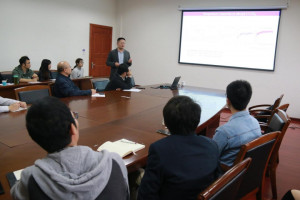Professor Cao Long from Zhejiang University Was Invited to Give an Academic Report to Our School
On the afternoon of October 17, at the invitation of the School of Atmospheric Sciences, Professor Cao Long, Associate Dean of the School of Earth Sciences at Zhejiang University, gave a report titled “Simulation Study on the Impact of Carbon Dioxide Emissions on the Earth’s Climate System” in Room 310 of the Meteorological Building. The report was presided over by Associate Professor Hua Wei. The teachers and students of the School of Atmospheric Sciences listened carefully to the report and actively discussed exchanges.
Professor Cao Long first introduced the response of the Earth’s climate system to CO2 changes at different scales, and then explained in detail the effects of the simulated CO2 while increasing to four times on the atmosphere, sea surface and land, and established a linear correlation. He pointed out that by studying the influence mechanism of different external forces on the climate system, it is found that the effects of solar radiation and CO2 on precipitation are inconsistent, but the effects on temperature are consistent. Finally, he introduced the ocean acidification simulation results and proposed some geoengineering recommendations that are effective for cooling the Earth. This report is important for us to understand the causes and solutions of large-scale global climate change.
After the report, the experts exchanged discussions with the teachers and students present, and patiently explained and answered questions for the students. This academic report has created a good academic exchange atmosphere and increased students’ interest in research on global climate change.
Expert introduction: Cao Long, professor of Zhejiang University, School of Earth Sciences, doctoral tutor, deputy dean of the School of Earth Sciences, winner of the National Youth Thousand Talents Program, and winner of the National Outstanding Youth Fund, director of the Chinese Meteorological Society. He has published more than 40 papers in international mainstream journals such as Nature Climate change, Journal of Geophysical Research. It has been cited more than 3,000 times.

